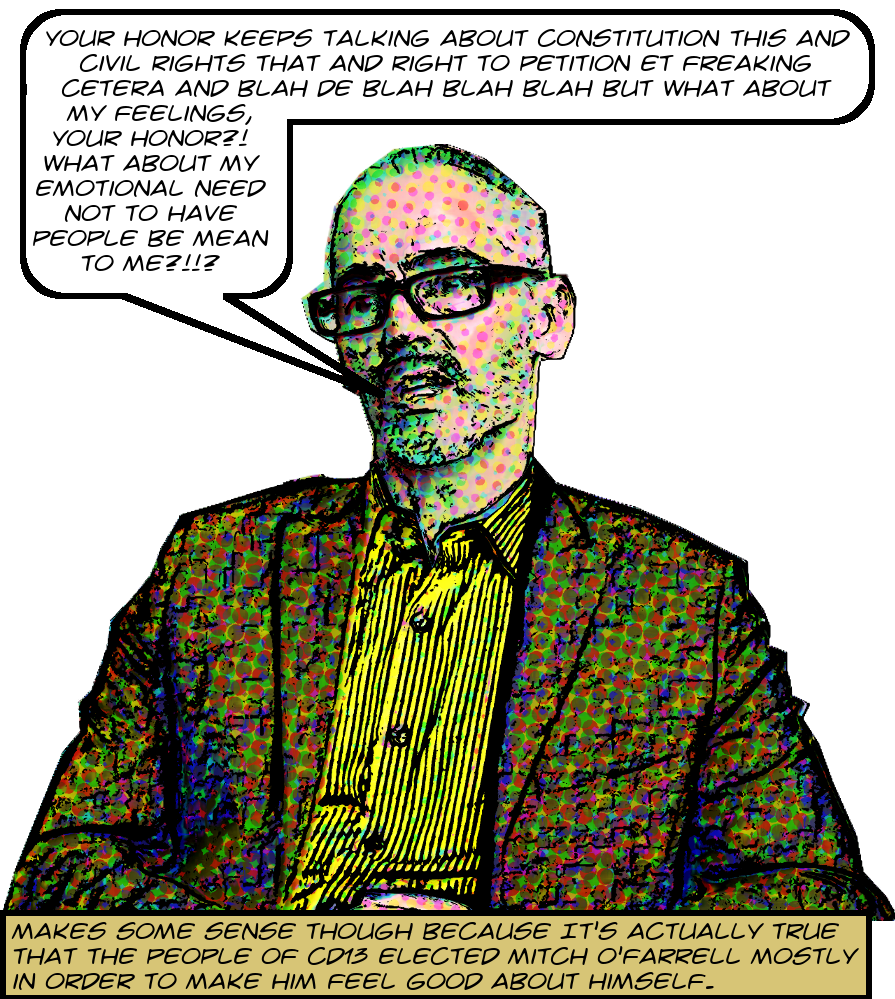 Mitch O’Farrell, the crying-little-babiest Councilmember in the whole City of Los Angeles, was soundly rebuked in his whiny ways by the California Court of Appeals, which last week issued an opinion reversing Superior Court Judge Elizabeth Allen White‘s dismissal of a lawsuit brought by the Beachwood Canyon Neighborhood Association against the City.1
Mitch O’Farrell, the crying-little-babiest Councilmember in the whole City of Los Angeles, was soundly rebuked in his whiny ways by the California Court of Appeals, which last week issued an opinion reversing Superior Court Judge Elizabeth Allen White‘s dismissal of a lawsuit brought by the Beachwood Canyon Neighborhood Association against the City.1
The dispute was over a planning meeting sponsored by CD13 in 2014, from which Hollywood activists George Abrahams and Doug Haines of the Association were physically barred by then-CD13 director of planning (and self-confessed criminal) Marie Rumsey. As the ruling summarized the story:
Petitioners alleged that on June 26, 2014, [a Hollywood Design Review Committee] meeting was held at the office of Lehrer Architects “to discuss various projects proposed for Hollywood.” Abrahams and other members of the public went to the meeting location, but “were denied entry to the building.” Haines was also denied access, but he entered the room anyway. When Haines picked up a copy of the meeting agenda from a table, Marie Rumsey, planning deputy for CD13, “pulled the agenda from his hand and physically shoved him toward the exit.” Meanwhile, “Abrahams observed groups of lobbyists entering the building at will.”
So the Association argued that the meeting was subject to the Brown Act and that their exclusion violated that law. Furthermore, they argued that O’Farrell had exluded them based on the fact that they disagreed with his positions on various issues, which violated the First Amendment:
Petitioners also alleged that on January 15, 2015, O’Farrell said that people who tried to “crash” HDRC meetings in the past would not be allowed to attend future meetings. Petitioners alleged that O’Farrell was “singling them out because of positions they have previously taken on matters of public concern, and because they have previously been involved in litigation against the City of Los Angeles.”
O’Farrell’s position was that the meeting was private, was not subject to the Brown Act, and that therefore he could exclude anyone he wanted to. The case went through a number of highly technical twists and directions, very few of which I understand well enough even to summarize, and finally, in December 2017, Judge White declared a nonsuit, which I guess is essentially a dismissal of some kind, and it’s that declaration that was appealed here and reversed by the Appellate court.
I assume, as I said, that this doesn’t mean the plaintiffs win, but just that there ought to be a trial. However, the court based its ruling on a judgment that if all the facts alleged by the plaintiff were true there would be sufficient evidence to show that O’Farrell did violate the First Amendment by excluding the plaintiffs from the meeting.
This is really important, of course. First because anyone who has anything adversarial to do with Mitch O’Farrell knows that the alleged facts are certainly true, and second because all the action takes place in these putatively advisory meetings. Once the lobbyists and the in-crowd agree on a course of action all the public deliberations are for nothing more than show. If these now-private planning meetings end up open to the public it will be a major victory.
Not necessarily a long-lasting one, of course, because one of the major superpowers of City officials is to route around every advance in transparency, and there’s no reason why this would be an exception.2 It is, nevertheless, important. If I find out anything more, of course, I will certainly let you know!
Image of Mitch O’Freaking Farrell is ©2019 MichaelKohlhaas.Org and then there was this one.
- Note that I am not a lawyer, and this story is about a fairly technical matter. I am reasonably sure that what I’m saying about this is accurate but not completely sure. As always, the point here is to present a copy of the actual record, in this case the appellate court’s opinion. Ultimately you’re going to have to judge for yourself what it all means. Of course the same is true with everything one reads. The real difference here is that I state it explicitly and always, always link to the primary sources.
- Obligatory quote from Kafka here, thoughtfully placed in a footnote so that if the pedantry disturbs you it’s easy to skip:“One must lie low, no matter how much it went against the grain, and try to understand that this great organization remained, so to speak, in a state of delicate balance, and that if someone took it upon himself to alter the dispositions of things around him, he ran the risk of losing his footing and falling to destruction, while the organization would simply right itself by some compensating reaction in another part of its machinery – since everything interlocked – and remain unchanged, unless, indeed, which was very probable, it became still more rigid, more vigilant, severer, and more ruthless.”
